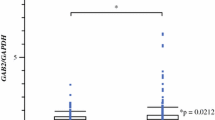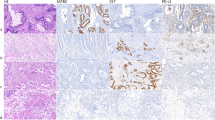Abstract
Background and aims
To date, the association between special AT-rich sequence-binding protein 1 (SATB1) and colorectal cancer (CRC) has not been reported. This study was aimed at investigating the expression and potential role of SATB1 in human rectal cancers.
Methods
Ninety-three paired samples of rectal cancer and distant normal rectal tissue were analyzed by quantitative real-time PCR (qRT-PCR) and immunohistochemistry (IHC), and the correlations between SATB1 expression and clinicopathological parameters were evaluated. The expression profiles of SATB1 were also investigated in a panel of five human colon carcinoma cell lines.
Results
The general level of SATB1 mRNA in rectal cancer tissues was statistically significantly higher than that in normal mucosa (P = 0.043). The rate of positive SATB1 protein expression in rectal cancers (44.1%) was significantly higher than that in normal tissues (25.8%) by IHC analysis (P = 0.009). Overexpression of SATB1 mRNA was more predominant in patients with earlier onset of rectal cancer (P = 0.033). SATB1 expression correlated with invasive depth and tumor node metastasis (TNM) stage at both protein and mRNA levels (P < 0.05). Furthermore, SATB1 expression in the poorly metastatic KM12C cells was significantly lower than the highly metastatic KM12SM and KM12L4A cells and higher than the HCT116 and SW480 cells (P = 0.001). These results were further confirmed by Western blotting.
Conclusion
Our results indicate that SATB1 may play an important role in the progression of human rectal cancer, which represents a possible new mechanism underlying CRC.


Similar content being viewed by others
References
Jemal A, Siegel R, Ward E, Murray T, Xu J, Smigal C, Thun MJ (2006) Cancer statistics, 2006. CA Cancer J Clin 56:106–130
Kouzarides T (1999) Histone acetylases and deacetylases in cell proliferation. Curr Opin Genet Dev 9:40–48
Alvarez JD, Yasui DH, Niida H, Joh T, Loh DY, Kohwi-Shigematsu T (2000) The MAR-binding protein SATB1 orchestrates temporal and spatial expression of multiple genes during T-cell development. Genes Dev 14:521–535
Kumar PP, Purbey PK, Sinha CK, Notani D, Limaye A, Jayani RS, Galande S (2006) Phosphorylation of SATB1, a global gene regulator, acts as a molecular switch regulating its transcriptional activity in vivo. Mol Cell 22:231–243
Wen J, Huang S, Rogers H, Dickinson LA, Kohwi-Shigematsu T, Noguchi CT (2005) SATB1 family protein expressed during early erythroid differentiation modifies globin gene expression. Blood 105:3330–3339
Cai S, Lee CC, Kohwi-Shigematsu T (2006) SATB1 packages densely looped, transcriptionally active chromatin for coordinated expression of cytokine genes. Nat Genet 38:1278–1288
Han HJ, Russo J, Kohwi Y, Kohwi-Shigematsu T (2008) SATB1 reprogrammes gene expression to promote breast tumour growth and metastasis. Nature 452:187–193
Zhao XD, Ji WY, Zhang W, He LX, Yang J, Liang HJ, Wang LL (2010) Overexpression of SATB1 in laryngeal squamous cell carcinoma. ORL J Otorhinolaryngol Relat Spec 72:1–5
Lu X, Cheng C, Zhu S, Yang Y, Zheng L, Wang G, Shu X, Wu K, Liu K, Tong Q (2010) SATB1 is an independent prognostic marker for gastric cancer in a Chinese population. Oncol Rep 24:981–987
Cheng C, Lu X, Wang G, Zheng L, Shu X, Zhu S, Liu K, Wu K, Tong Q (2010) Expression of SATB1 and heparanase in gastric cancer and its relationship to clinicopathologic features. APMIS 118:855–863
Wang S, Zhou J, Wang XY, Hao JM, Chen JZ, Zhang XM, Jin H, Liu L, Zhang YF, Liu J, Ding YQ, Li JM (2009) Down-regulated expression of SATB2 is associated with metastasis and poor prognosis in colorectal cancer. J Pathol 219:114–122
Edge SB, Byrd DR, Compton CC, Fritz AG, Greene FL, Trotti A (2010) AJCC Cancer staging manual, 7th edn. Springer, New York, pp 143–164
Pfaffl MW (2001) A new mathematical model for relative quantification in real-time RT-PCR. Nucleic Acids Res 29:e45
Remmele W, Stegner HE (1987) Recommendation for uniform definition of an immunoreactive score (IRS) for immunohistochemical estrogen receptor detection (ER-ICA) in breast cancer tissue. Pathology 8:138–140
Pfaffl MW, Horgan GW, Dempfle L (2002) Relative expression software tool (REST) real-time PCR. Nucleic Acids Res 30:e36
Zheng J (2008) Is SATB1 a master regulator in breast cancer growth and metastasis? Women’s Health (Lond Engl) 4:329–332
Yasui D, Miyano M, Cai S, Varga-Weisz P, Kohwi-Shigematsu T (2002) SATB1 targets chromatin remodelling to regulate genes over long distances. Nature 419:641–645
Cai S, Han HJ, Kohwi-Shigematsu T (2003) Tissue-specific nuclear architecture and gene expression regulated by SATB1. Nat Genet 34:42–51
Yokota J (2000) Tumor progression and metastasis. Carcinogenesis 21:497–503
Purbey PK, Singh S, Notani D, Kumar PP, Limaye AS, Galande S (2009) Acetylation-dependent interaction of SATB1 and CtBP1 mediates transcriptional repression by SATB1. Mol Cell Biol 29:1321–1337
Notani D, Gottimukkala KP, Jayani RS, Limaye AS, Damle MV, Mehta S, Purbey PK, Joseph J, Galande S (2010) Global regulator SATB1 recruits β-catenin and regulates TH2 differentiation in Wnt-dependent manner. PLoS Biol 8:e1000296
Kongkanuntn R, Bubb VJ, Sansom OJ, Wyllie AH, Harrison DJ, Clarke AR (1999) Dysregulated expression of β-catenin marks early neoplastic change in Apc mutant mice, but not all lesions arising in Msh2 deficient mice. Oncogene 18:7219–7225
Acknowledgements
This study was supported by the National Natural Science Foundation of China (No. 30830100) and Ph.D. Programs Foundation of the Ministry of Education of China (No. 20080610058). We thank Yong Liu and Yang Li for their technical assistance.
Author information
Authors and Affiliations
Corresponding author
Electronic supplementary material
Below is the link to the electronic supplementary material.
Fig. S1
The relative expressions of SATB1 mRNA in five colon cancer cell lines detected by qRT-PCR. The amplification curves and corresponding Ct values of SATB1 and β-actin gene (reference gene) are shown. The experiment was repeated three times (JPEG 61 kb)
Rights and permissions
About this article
Cite this article
Meng, WJ., Yan, H., Zhou, B. et al. Correlation of SATB1 overexpression with the progression of human rectal cancer. Int J Colorectal Dis 27, 143–150 (2012). https://doi.org/10.1007/s00384-011-1302-9
Accepted:
Published:
Issue Date:
DOI: https://doi.org/10.1007/s00384-011-1302-9




